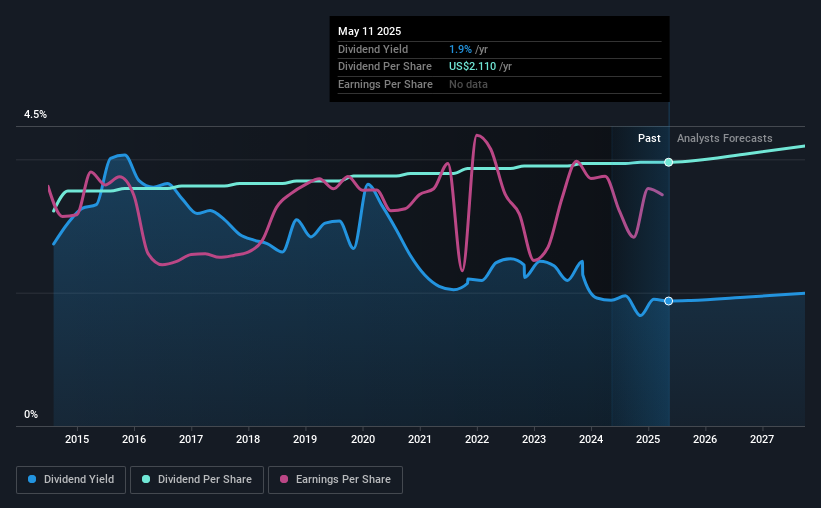
Emerson Electric Co. (NYSE:EMR) stock is about to trade ex-dividend in 4 days. The ex-dividend date is usually set to be one business day before the record date, which is the cut-off date on which you must be present on the company's books as a shareholder in order to receive the dividend. The ex-dividend date is of consequence because whenever a stock is bought or sold, the trade takes at least one business day to settle. Meaning, you will need to purchase Emerson Electric's shares before the 16th of May to receive the dividend, which will be paid on the 10th of June.
The company's next dividend payment will be US$0.5275 per share. Last year, in total, the company distributed US$2.11 to shareholders. Looking at the last 12 months of distributions, Emerson Electric has a trailing yield of approximately 1.9% on its current stock price of US$112.55. Dividends are an important source of income to many shareholders, but the health of the business is crucial to maintaining those dividends. So we need to investigate whether Emerson Electric can afford its dividend, and if the dividend could grow.
Dividends are typically paid out of company income, so if a company pays out more than it earned, its dividend is usually at a higher risk of being cut. Emerson Electric paid out 61% of its earnings to investors last year, a normal payout level for most businesses. A useful secondary check can be to evaluate whether Emerson Electric generated enough free cash flow to afford its dividend. It distributed 43% of its free cash flow as dividends, a comfortable payout level for most companies.
It's positive to see that Emerson Electric's dividend is covered by both profits and cash flow, since this is generally a sign that the dividend is sustainable, and a lower payout ratio usually suggests a greater margin of safety before the dividend gets cut.
View our latest analysis for Emerson Electric
Click here to see the company's payout ratio, plus analyst estimates of its future dividends.

Have Earnings And Dividends Been Growing?
Companies that aren't growing their earnings can still be valuable, but it is even more important to assess the sustainability of the dividend if it looks like the company will struggle to grow. If earnings fall far enough, the company could be forced to cut its dividend. That explains why we're not overly excited about Emerson Electric's flat earnings over the past five years. Better than seeing them fall off a cliff, for sure, but the best dividend stocks grow their earnings meaningfully over the long run.
Many investors will assess a company's dividend performance by evaluating how much the dividend payments have changed over time. Emerson Electric has delivered 2.1% dividend growth per year on average over the past 10 years.
To Sum It Up
Has Emerson Electric got what it takes to maintain its dividend payments? We're not enthused by the flat earnings per share, although at least the company's payout ratio is within reasonable bounds. Additionally, it paid out a lower percentage of its free cash flow, so at least it generated more cash than it spent on dividends. In summary, it's hard to get excited about Emerson Electric from a dividend perspective.
If you're not too concerned about Emerson Electric's ability to pay dividends, you should still be mindful of some of the other risks that this business faces. Our analysis shows 2 warning signs for Emerson Electric and you should be aware of them before buying any shares.
If you're in the market for strong dividend payers, we recommend checking our selection of top dividend stocks.
Have feedback on this article? Concerned about the content? Get in touch with us directly. Alternatively, email editorial-team (at) simplywallst.com.
This article by Simply Wall St is general in nature. We provide commentary based on historical data and analyst forecasts only using an unbiased methodology and our articles are not intended to be financial advice. It does not constitute a recommendation to buy or sell any stock, and does not take account of your objectives, or your financial situation. We aim to bring you long-term focused analysis driven by fundamental data. Note that our analysis may not factor in the latest price-sensitive company announcements or qualitative material. Simply Wall St has no position in any stocks mentioned.